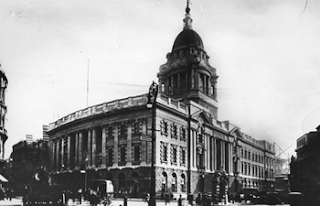BATTERBERRY, Ariane Ruskin & Michael BATTERBERRY
(1977) Fashion, The Mirror of History (New
York: Greenwich House)
BAZIN, Germain (1964) Baroque and Rococo (London: Thames and Hudson)
BENNET OATES, Phyllis (1981) The Story of Western Furniture (London: Herbert Press)
BERNINI, Gian Lorenzo (2013) ‘Bust of Louis XIV’ in Web Gallery of Art <http://www.wga.hu/frames-e.html?/html/b/bernini/gianlore/sculptur/1640/therese1.html>
[accessed 29 May 2010]
BERNINI, Gian Lorenzo (2013) ‘Ecstasy of St. Teresa’
in Web Gallery of Art <http://www.wga.hu/frames-e.html?/html/b/bernini/gianlore/sculptur/1640/therese1.html>
[accessed 29 May 2013]
BUSSAGLI, Mario (2004) Italian Art (Firenze: Giunti Editore)
BUSSAGLI Mario & Mattia Reiche (2009) Baroque and Rococo (New York: Sterling Publishing Company)
CLAUS, Karl H. & Victoria Charles (2009) Baroque Art (New York: Parkstone
International)
CLARK, Kenneth (1969) Civilisation, A Personal View (London: British Broadcasting
Corporation)
DOWNES, Kerry (2013) ‘Baroque’ in Grove Art Online, Oxford Art Online
<http://www.oxfordartonline.com> [accessed 29 May 2013]
FAHY, Everett (2003) ‘Velasquez (1599-1660)’ in Heilbrunn Timeline of Art History The
Metropolitan Museum of Art <http://www.metmuseum.org> [accessed 29
May 2013]
FICHNER-RATHUS, Lois (2011) Foundations of Art and Design
(Connecticut: Cengage Learning)
GORSLINE, Douglas (1953) A History of Fashion: A Visual Survey of Costume from Ancient Times (London:
Fitzhouse Books)
GARDNER, Helen, et al. (2006) Gardner’s Art Through The Ages: The Western Perspective vol.2 (Connecticut:
Cengage Learning)
KERNODLE, George R. (1989) The Theatre in History (Fayetteville: University of Arkansas Press)
KLEINER, Fred S. (2010) Gardner’s Art Through the Ages: A Global History (Connecticut:
Cengage Learning)
KOSTOF, Spiro (1985) A History of Architecture: settings and
rituals (Oxford: Oxford University Press)
LUCIE-SMITH, Edward (1979) Furniture: A Concise History (London: Thames and Hudson)
MOUNTFORD, E.W. (2013) ‘Interior of the Old Bailey’ in British Broadcasting Company News <http://news.bbc.co.uk/1/shared/spl/hi/pop_ups/07/in_pictures_the_old_bailey_at_100/html/5.stm[accessed 29 May 2013]
MOUNTFORD, E.W. (2013) ‘Exterior of the Old Bailey' in British Broadcasting Company News <http://news.bbc.co.uk/1/shared/spl/hi/pop_ups/07/in_pictures_the_old_bailey_at_100/html/1.stm[accessed 29 May 2013]ZIRPOLO, Lilian H. (2010) ‘Town hall of Amsterdam’ in Dictionary of Baroque Art and Architecture (Maryland: Rowman&Littlefield)
MUNGER, Jeffrey (2003) ‘French
Silver in the Seventeenth and Eighteenth Centuries’ in Heilbrunn Timeline of
Art History, The Metropolitan Museum of Art <http://www.metmuseum.org>
[accessed 29 May 2013]
MUNGER, Jeffrey & Alice Cooney Frenlinghuysen
(2003) ‘East and West: Chinese export porcelain’ in Heilbrunn Timeline of Art History, The Metropolitan Museum of Art <http://www.metmusem.org>
[accessed 29 May 2013]
NORMAN, Larry F. (2001) ‘The
Theatrical Baroque: European Plays, Painting and Poetry,
1575-1725’ <
http://fathom.lib.uchicago.edu/2/10701023/
ORREY, Leslie (1972) Opera, A Concise History (London: Thames and Hudson)
PALMER, Alison Lee (2009) ‘Jacob
van Campen’ in The A to Z of Architecture
(Maryland: Scarecrow Press)
SCHAMA, Simon (2010) Power of Art: Bernini Directed by Clare Beavan (London: British
Broadcasting Company)
SERVICE, Alastair (2013) ‘Baroque revival’ in Grove Art Online. Oxford Art Online.<http://www.oxfordartonline.com>
[accessed 29 May 2013]
THE METROPOLITAN MUSEUM OF ART (2006a) ‘The Supper
at Emmaus’ in Heilbrunn Timeline of Art
History, The Metropolitan Museum of Art <http://www.metmuseum.org>
[accessed 29 May 2013]
THE METROPOLITAN
MUSEUM OF ART (2006b) ‘Dish [Chinese for the European market]’ in Heilbrunn Timeline of Art History, The
Metropolitan Museum of Art [accessed 29 May 2013]
THE METROPOLITAN
MUSEUM OF ART (2006c) ‘Plate’ in Heilbrunn
Timeline of Art History, The Metropolitan Museum of Art [accessed 29 May 2013]
THE METROPOLITAN
MUSEUM OF ART (2006d) ‘Fork and spoon [French; Paris]’ in Heilbrunn Timeline of Art History, The
Metropolitan Museum of Art [accessed 29 May 2013]
THE METROPOLITAN MUSEUM OF ART (2008) ‘Ludovico
Carracci: The Lamentation’ in Heilbrunn
Timeline of Art History, The Metropolitan Museum of Art <http://www.metmusem.org>
[accessed 29 May 2013]
VICTORIA & ALBERT MUSEUM (2009)
‘Baroque: The First Global Style’ <http://www.vam.ac.uk/content/articles/b/the-baroque/ [accessed 27 May 2013]
VICTORIA & ALBERT MUSEUM
(2009b) ‘Ceramics for the baroque court’ <
http://www.vam.ac.uk/content/articles/c/ceramics-for-the-baroque-court>[accessed 27 May 2013]
WHINNEY, Margaret (1992) Sculpture in Britain: 1530-1830 (Connecticut:
Yale University Press)
WATKIN, David (2010) A History of Western Architecture (London:
Laurence King Publishing)




































